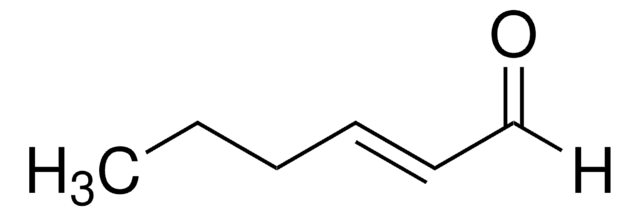Wichtige Dokumente
W317101
cis-3-Hexenylacetat
≥98%, stabilized, FCC, FG
Synonym(e):
(3Z)-3-Hexen-1-ol acetate, (3Z)-C-3-Hexenyl acetate, Leaf acetate
About This Item
Empfohlene Produkte
Biologische Quelle
synthetic
Qualitätsniveau
Qualität
FG
Fragrance grade
Halal
Kosher
Agentur
follows IFRA guidelines
Einhaltung gesetzlicher Vorschriften
EU Regulation 1223/2009
EU Regulation 1334/2008 & 178/2002
FCC
Assay
≥98%
Enthält
α-tocopherol, synthetic as stabilizer
Brechungsindex
n20/D 1.427 (lit.)
bp
75-76 °C/23 mmHg (lit.)
Dichte
0.897 g/mL at 25 °C (lit.)
Anwendung(en)
flavors and fragrances
Dokumentation
see Safety & Documentation for available documents
Nahrungsmittelallergen
no known allergens
Allergener Duftstoff
no known allergens
Organoleptisch
fresh; green; fruity; sweet
SMILES String
[H]\C(CC)=C(/[H])CCOC(C)=O
InChI
1S/C8H14O2/c1-3-4-5-6-7-10-8(2)9/h4-5H,3,6-7H2,1-2H3/b5-4-
InChIKey
NPFVOOAXDOBMCE-PLNGDYQASA-N
Suchen Sie nach ähnlichen Produkten? Aufrufen Leitfaden zum Produktvergleich
Verwandte Kategorien
Allgemeine Beschreibung
Anwendung
- Volatiles from cotton aphid (Aphis gossypii) infested plants attract the natural enemy Hippodamia variegata.: This study explored how volatiles, including cis-3-Hexenyl acetate, emitted by cotton plants infested with Aphis gossypii attract the natural predator Hippodamia variegata, highlighting its potential in biological pest control strategies (Yi et al., 2023).
Biochem./physiol. Wirkung
Signalwort
Warning
H-Sätze
Gefahreneinstufungen
Flam. Liq. 3
Lagerklassenschlüssel
3 - Flammable liquids
WGK
WGK 2
Flammpunkt (°F)
134.6 °F
Flammpunkt (°C)
57 °C
Persönliche Schutzausrüstung
Eyeshields, Gloves, multi-purpose combination respirator cartridge (US)
Hier finden Sie alle aktuellen Versionen:
Besitzen Sie dieses Produkt bereits?
In der Dokumentenbibliothek finden Sie die Dokumentation zu den Produkten, die Sie kürzlich erworben haben.
Kunden haben sich ebenfalls angesehen
Global Trade Item Number
| SKU | GTIN |
|---|---|
| W317101-1KG | |
| W317101-200G | |
| W317101-1KG-K | 4061837527920 |
| W317101-200G-K | 4061837545986 |
| W317101-5KG | |
| W317101-5KG-K | |
| W317101-SAMPLE | |
| W317101-SAMPLE-K | 4061837527937 |
Unser Team von Wissenschaftlern verfügt über Erfahrung in allen Forschungsbereichen einschließlich Life Science, Materialwissenschaften, chemischer Synthese, Chromatographie, Analytik und vielen mehr..
Setzen Sie sich mit dem technischen Dienst in Verbindung.








